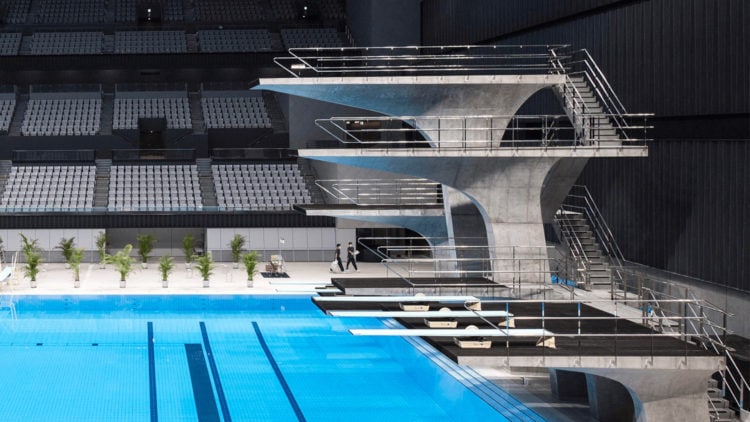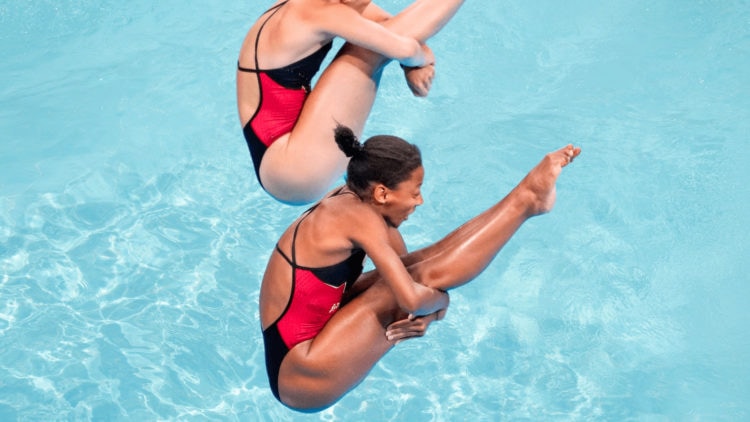
OBJECTIVE OF DIVING: Score the most points by performing impressive mid-air acrobatic stunts while diving into a pool.
NUMBER OF PLAYERS: 1+ player(s)
MATERIALS: Diving board, swimsuit
TYPE OF GAME: Sport
AUDIENCE: 8+
OVERVIEW OF DIVING
Diving is an Olympic water sport in which competitors jump off of a platform and perform acrobatic tricks in the air before splashing down into a pool. There are three main diving disciplines—springboard diving, platform, and synchronized—although each is entirely concerned with the diving technique and degree of difficulty of each competitor’s dive.
The sport of diving was popularized in Europe in the late 1800s, with Britain hosting the first-ever competitive diving championships in Scotland in 1889. At the start, diving was very simplistic, with the style used during this time becoming known as “plain diving” or “plunging”. Competitors were mostly focused on diving into the water from great heights, with little attention given to fancy stunts or acrobatics.
Less than a decade after the first diving championship was held in Scotland, a Swedish diver by the name of Otto Hagborg introduced the British to the sport of “fancy diving”. This new form of diving, which gymnasts developed as a method of performing their stunts with a soft landing, has grown into the sport of diving that is most prevalent today.
SETUP
EVENTS & DIVES

There are three main diving disciplines: springboard, platform, and synchronized. For both springboard and platform, competitors must perform dives that incorporate the following elements:
- Forward: A classic dive in which the athlete faces away from the diving board and toward the pool.
- Backward: The opposite of a forward dive, an athlete must face away from the water and jump backward off of the board.
- Reverse: A dive in which the athlete jumps off the board in a forward position before reversing their spin (backward spin).
- Inward: The opposite of a reverse dive, an athlete jumps backward off the board before reversing into a forward spin.
- Twisting: A dive that incorporates both spins and twists (rotations along two axes)
Each of the three diving events has its own specific rules and requirements:
- Springboard: Dives are completed from a one or three-meter-high springboard. Competitors must perform one dive for each of the five categories listed above. Men perform six dives (the sixth dive is a repeat of any of the prior five dive categories), and women perform five. There is no required difficulty for each dive attempt.
- Platform: Dives are completed from a five or ten-meter-high platform. Similar to springboard, competitors must perform one dive for each of the five listed categories, with men performing six dives and women performing five. There is no required difficulty for each dive attempt.
- Synchronized: Synchronized dives can be done from the springboard or platform, depending on the competition. In these dives, two athletes must perform identical stunts in synchronization. As with the other events, men complete six dives while women complete five. Four of the dives must be of the categories listed above, although one of the dives must be from a non-standing starting position (such as a handstand). The first two dives must be of a 2.0 difficulty, which is a very simple dive.
GAMEPLAY
SCORING & JUDGING

Dives are scored by a panel: seven judges for springboard and platform events and 11 for synchronization events. These judges are rating every aspect of their dive, including:
- Approach: To begin their dive, competitors should take a minimum of three steps toward the end of the board/platform. This forward movement can help a diver generate more force on their takeoff, allowing them more time in the air.
- Takeoff: Divers must exit the board/platform with the proper launch angle and technique for the specific dive they’re attempting. Judges are particularly looking for the use of stellar control and balance through this phase.
- Elevation: As with most acrobatic sports, more air time equates to a more spectacular display. This is precisely why judges are hoping to see an athlete’s takeoff phase result in them gaining great height, as this often leads to a more graceful dive.
- Execution: Clearly, a proper dive setup is redundant without a dazzling dive to accompany it. When judging the execution of the dive itself, the judging panel is looking for proper use of mechanics, form, technique, and grace.
- Entry: As how the landing can make or break a gymnastic stunt, a diver’s entry can wholly dictate the success of their dive. For a perfect entry, judges are looking for verticality and subtle splashing.
For synchronization events, an extra judges score is provided regarding the synchronized, or matched, movements of the two divers.
When considering diving scores, judges factor in both the execution and difficulty of an attempt. Each judge provides a final score based on the categories above, up to a maximum score of 10 in half point increments:
- Perfect Score: 10
- Excellent: 8.5–9.5
- Good: 7–8
- Satisfactory: 5–6.5
- Deficient: 2.5–4.5
- Unsatisfactory: 0.5–2
- Failed Attempt: 0
In individual diving events with only 5 judges the highest and lowest scores are ignored and the remaining three scores are used to calculate the end score. In competition with 7 judges the highest and lowest are ignored again and the remaining scores are summed.
THE HIGHEST DIVE OF ALL TIME
Rick Charls World Record High Dive 172′
American diver Rick Charls is credited with the highest successful dive of all time: a 172-foot dive in 1983. Since this day, many people have tried to challenge this record, although no one has managed to do so with a flip and without sustaining serious injury.
58.8m High Dive World Record Full Version
In 2015, a Swiss-Brazilian diver named Lazaro Schaller completed a successful dive of 193 feet. However, this dive did not include any spins (as Charls’s did), and Schaller was noticeably shaken after the landing.
END OF GAME
At the end of the competition, the competitor/team with the highest combined point total from all of their dives is deemed the winner.
- 30 GAMES TO PLAY OVER TEXT - April 22, 2024
- 20+ FREE PRINTABLE BABY SHOWER GAMES - April 16, 2024
- 20+ College Party Games for the Best Night Ever! - April 2, 2024